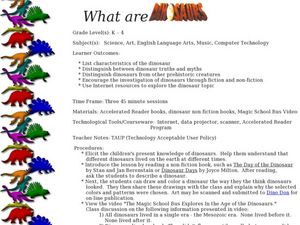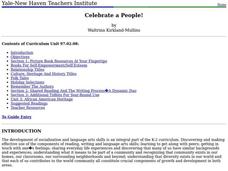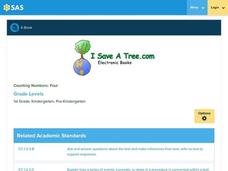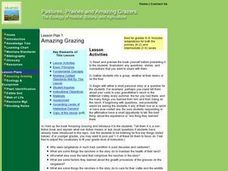Pennsylvania Department of Education
Comparing Key Ideas and Details in Fiction and Nonfiction
Learners recognize the differences between fiction and nonfiction texts. For this genre study lesson, students discuss what nonfiction means and write the definition. Learners listen to a read aloud and vote whether the text is fiction...
Curated OER
The Seeds We Need
Learners apply word analysis skills to recognize new words, identify genres of fiction and nonfiction, and identify important themes and topics. They explore differences in plants, flowers, and vegetables. A book bag full of activities...
Curated OER
Non-Fiction Read-aloud
Students listen to the reading of a book about the area of science they are currently studying.
Curated OER
"My Body"
Students participate in various shared reading and writing activities related to the book "My Body" by Rhonda Jenkins. They identify and list words that could be used to label other body parts in the book, draw a picture of their face...
Pennsylvania Department of Education
Stories? Information? What's the Difference?
Students listen to a power point presentation to distinguish between fiction and nonfiction text. In this what's the difference lesson, students identify fact from opinion within a text. Students listen critically and respond to text.
Curated OER
What are Dinosaurs?
Learners explore the attributes of dinosaurs. In this dinosaur lesson, students read books and watch videos featuring dinosaurs. Learners also research dinosaur traits using Internet sources.
Curated OER
Minty
Students investigate, read, and discuss about other famous Afro-American leaders. Students compare/contrast slaves home, activities, etc. with that of Afro- Americans today. Students create a time line to post on the wall of Harriet's...
Curated OER
Build Mastery: Cause and Effect
After you've begun identifying the cause and effect relationship within literature, it's time to give scholars some independent practice. Review the concept before handing out this graphic organizer. Learners use the book they are...
Curated OER
Celebrate A People!
Students explore African-American students literature as an integral building block in empowering all students to a better awareness when reading and writing. They use as a productive Social Studies tool for overall understanding of the...
Pennsylvania Department of Education
Counting Numbers: Four
Students practice counting to four. In this counting to four lesson, students access an e-book at "I Save A Tree.com" where they count items up to four. They examine the text and images which can be seen in both Spanish and English.
Pennsylvania Department of Education
The Letter B (b)
Students discover words through text, audio and images that begin with the letter B. In this letter B lesson, students download an ebook and navigate through an interactive reading activity.
Curated OER
Amazing Grazing
Students discuss their experiences on a ranch. As a class, they tell the best part of their experiences or one thing they gathered from being on the ranch. They listen to the story and identify five items to focus on in the reading and...
Curated OER
The Life And Times Of The Apple
Students engage in a study about the biology of apples that includes growth and reproduction. They conduct research using a variety of resources. Students write a description of an apple brought to class by answering several questions....
Curated OER
Patterned Leaf Cloths
Students identify and reproduce simple patterns (e.g., red blocks alternating with blue blocks; clap-clap-stamp) and create and extend simple patterns using a variety of materials or actions (e.g., popsicle sticks, pebbles, stickers,...















